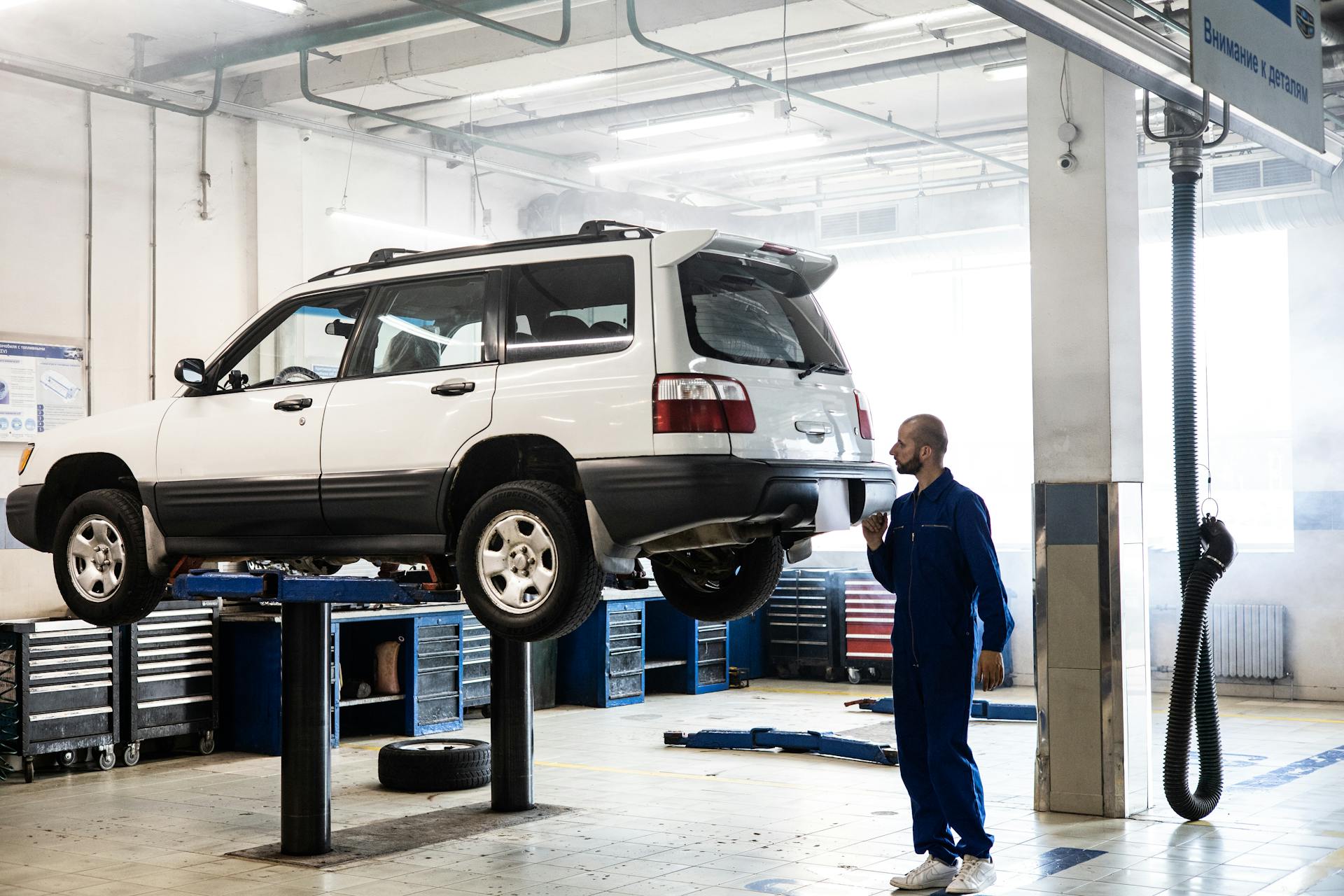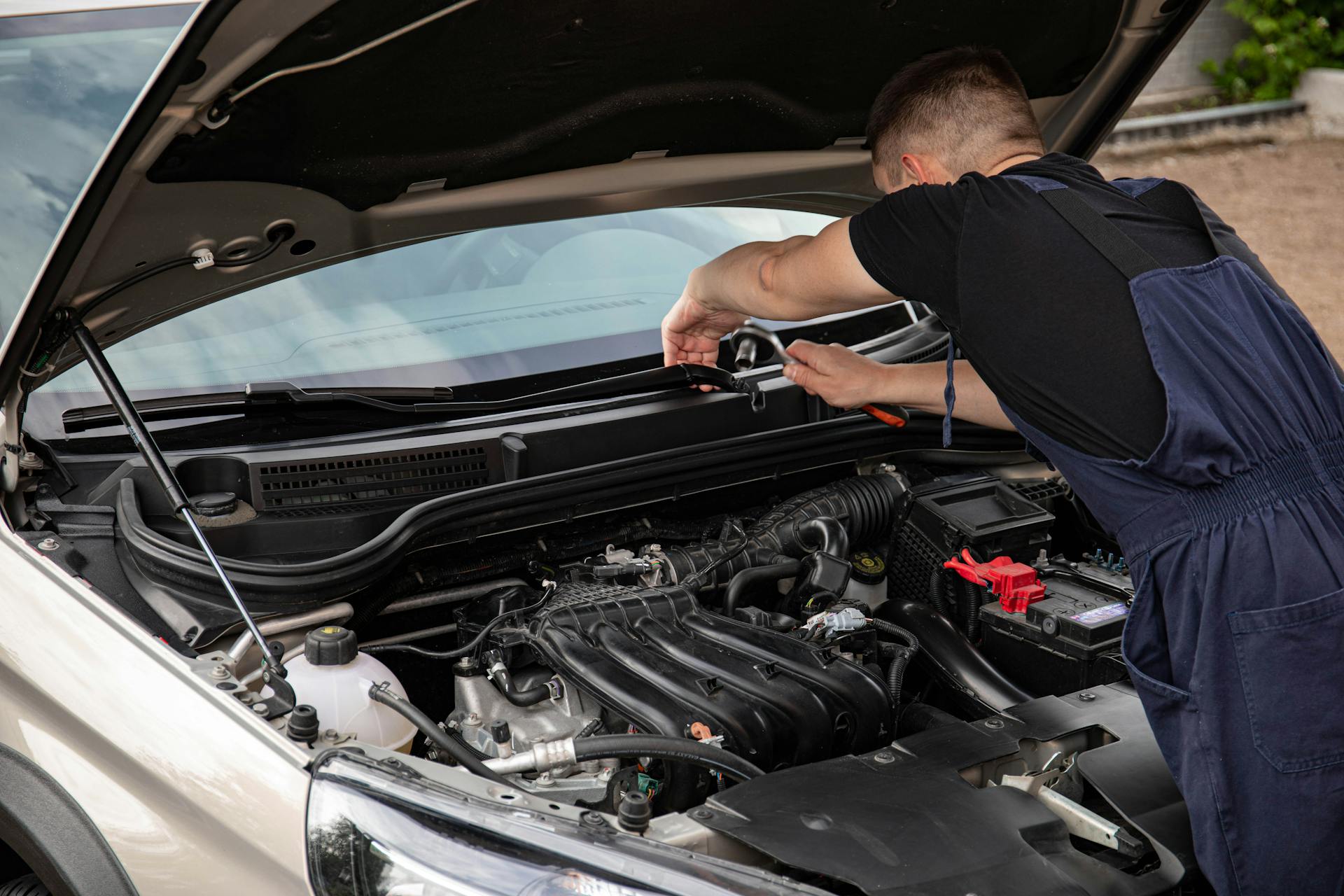
Returning a leased car can be a daunting task, but there are several options to consider. You can return your car to the leasing company at the end of the lease term.
One option is to purchase the car, which can be beneficial if you've grown attached to your vehicle. According to the lease agreement, you can buy the car at a predetermined price, known as the residual value.
You can also return the car to the leasing company and walk away with no further financial obligations. This option is often referred to as a "walk-away" lease.
Another benefit of returning a leased car is that you won't have to worry about selling the vehicle yourself. The leasing company will handle the sale, and you'll receive any remaining equity in the car.
A different take: Leased Car
Lease Return Process
The lease return process can seem daunting, but it's actually quite straightforward. Most drivers who lease have a 36-month lease term.
You'll start receiving reminders from the leasing company around 90 days before your lease period is up. This is when you should begin preparing for the return process.
To return a leased car, you'll need to set up an appointment at a franchise dealership. They may even arrange for a flatbed truck to pick up your vehicle. The dealership will inspect your car to determine the condition and any damages.
Gather all the necessary documents and items, including the original lease paperwork, both sets of keys or key fobs, the owner's manual, and the spare tire and jack. Make sure everything is in good condition.
The leasing company will inspect your car for excessive wear and tear, including dings, dents, scrapes, or scratches on the exterior, stains, burns, tears, or rips on the interior, and cracks or pitting in the windshield or other windows.
Here's a checklist of what to expect during the inspection:
- Dings, dents, scrapes, or scratches on the exterior.
- Stains, burns, tears, or rips on the interior.
- Cracks or pitting in the windshield, sunroof, or other windows.
- Tire wear.
- Missing or non-working equipment and other damage to the vehicle.
After the inspection, you'll receive a condition report outlining the damages identified and the costs associated with them. Contact the leasing company to determine the location you should return your vehicle to and schedule an appointment to expedite the process.
Expand your knowledge: What Is a Class B Share
Lease Return Options
You've got options when it's time to return your leased car. A lessee has a few options after making the final payment to satisfy the car lease terms, which, for most drivers who lease, is 36 months.
You can lease or buy another vehicle from the same brand, as many manufacturers will incentivize returning lessees with financial incentives such as loyalty rebates and waived last few lease payments.
Returning your leased car at Cartelligent can make the process efficient while getting you a great price on a new vehicle. Call their team of car-leasing experts at 888-427-4270 or get started today.
You can also simply return the car and walk away, as you are no longer responsible for the vehicle when the lease terminates.
If you need more time, you can extend your lease by a few months, but this should be a last resort as it may come with additional fees.
Readers also liked: Leased Car Early Honda
Walk Away
You can walk away from your leased car after making the last payment and settling any related fees. This is as simple as it sounds.
When the lease terminates, you are no longer responsible for the vehicle and cannot use it.
After the lease ends, you can return the car and walk away, free from any further obligations.
Lease a Same-Brand Vehicle
Leasing a same-brand vehicle can be a great option, especially if you're happy with your current car and want to stick with the same manufacturer. Many manufacturers will incentivize returning lessees to choose another vehicle from their brand.
You can expect to receive financial incentives such as loyalty rebates, which can help offset the cost of your new lease. Some manufacturers will even waive the last few lease payments to help you get into the newer model before your lease is over.
If you're considering leasing a same-brand vehicle, be sure to explore the current offers from your manufacturer. You may be able to find a great deal on a new car, and it's definitely worth investigating.
Curious to learn more? Check out: Who Will Refinance My Mortgage with Late Payments
Waived Disposition Fee
A waived disposition fee can be a huge perk when returning a leased car. This fee is usually due when the leased vehicle is returned, but its amount will be specified in your contract.
Some brands will waive this charge if you lease another vehicle with them. This is a great opportunity to upgrade to a new ride without any extra costs.
Your disposition fee could be waived if you lease or buy a new GM vehicle at lease end. Explore their current offers to find your next ride.
For another approach, see: Can You Lease a Car without Credit
Lease Return Fees
Lease Return Fees can be a surprise, but understanding them can save you money. Many brands will waive the disposition fee if you lease another vehicle with them.
A disposition fee is usually due when the leased vehicle is returned, and the exact amount will be specified in your contract. This fee can be a significant charge, so it's essential to review your contract.
Broaden your view: Will Insurance Cover Semaglutide for Pcos
You should expect to receive your lease-end liability invoice up to 30-45 days after your vehicle has been returned. This invoice will detail any charges you owe, including mileage overage, excess wear, late charges, and disposition fees.
Potential lease-end charges can include mileage overage, excess wear, late charges, and disposition fees. These charges can add up quickly, so it's crucial to review your lease contract carefully.
Every leased car must be returned by the lease termination date on the contract. The vehicle can be returned to any dealer of the same brand, but beyond the termination date, fees will begin to accrue.
If your estimated mileage will be over your allowance, you have three options: either arrange to drive the vehicle less, pay the mileage penalty at the end of the lease, or buy the vehicle at the end of the lease. The mileage penalty is typically $0.15-$0.30 per mile, depending on the brand.
Here are some key facts to keep in mind:
- Under-mileage: If your estimated mileage will be under your allowance, you can just return the vehicle at the end of the lease.
- Over-mileage: If your estimated mileage will be over your allowance, you have three options: arrange to drive the vehicle less, pay the mileage penalty, or buy the vehicle at the end of the lease.
Lease Return Checklist
As you approach the end of your car lease, it's essential to prepare your vehicle for return to avoid unnecessary charges. Start by checking your lease agreement for the return process and any specific requirements. You'll typically receive reminders from the leasing company around 90 days before the lease period is up.
Gather all the necessary documents, including the original lease paperwork, owner's manual, and any extra keys or key fobs. Make sure the spare tire and jack are secure and easily accessible. You should also remove any personal items, toll passes, and documentation from the glove box.
To avoid excess wear and tear charges, thoroughly clean the interior and exterior of the vehicle. Consider having it detailed to make a good impression. Take note of any dings, dents, or scratches on the exterior and make sure to address any minor issues before the inspection.
Here's a checklist to ensure you're prepared for the return:
- Original lease paperwork
- Owner's manual
- Extra keys or key fobs
- Spare tire and jack
- Personal items, toll passes, and documentation removed from the glove box
- Vehicle thoroughly cleaned and detailed
- Minor issues addressed (dings, dents, scratches, etc.)
- Odometer reading recorded
Keep in mind that the leasing company may require an inspection of your vehicle before accepting it back. Be sure to review the excess wear and tear guidelines in your lease agreement to understand what is considered excessive wear and tear.
Sources
- https://www.kbb.com/car-advice/returning-a-lease-vehicle/
- https://cartelligent.com/preparing-to-turn-in-your-leased-car/
- https://www.ally.com/auto/lease-end/return-your-leased-vehicle/
- https://www.chase.com/personal/auto/education/leasing/returning-a-leased-car
- https://www.gmfinancial.com/en-us/resources/lease-end.html
Featured Images: pexels.com


